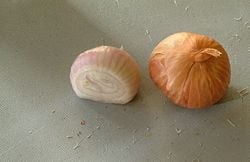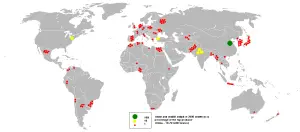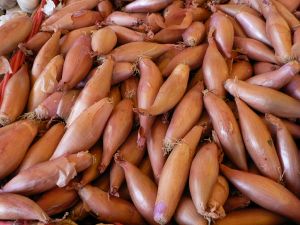Difference between revisions of "Shallot" - New World Encyclopedia
Rick Swarts (talk | contribs) |
Rick Swarts (talk | contribs) |
||
| Line 16: | Line 16: | ||
| − | '''Shallot''' is the common name for an edible, bulbous, [[herbaceous]] [[plant]], which is related to the [[onion]] (''Allium cepa''), but has a cluster of small bulbs rather than a single large bulb, each covered by a thin, papery skin. Plants known as shallots are variously classified as a variety of onion, '''''Allium cepa''''' var. '''''aggregatum''''' (GRIN 2008a; PFAF 2008a), or as a separate species, '''''A. ascalonicum''''' (Herbst 2001; PFAF 2008a), with such apparent synonyms used as ''A. cepa ascalonicum'' (PFAF 2008a), ''A. cepa'' aggregatum Group (GRIN 2008a; Bender and Bender 2005), and ''A. escalonium'' (Bender and Bender 2005). Another common name is '''multipler onion''' (GRIN 2008a). While potato onion also is used as a common name (PFAF 2008b; GRIN 2008a), it generally is seen as a particular variety of shallot with larger bulbs (PFAF 2008b). | + | '''Shallot''' is the common name for an edible, bulbous, [[herbaceous]] [[plant]], which is related to the [[onion]] (''Allium cepa''), but has a cluster of small bulbs rather than a single large bulb, each covered by a thin, papery skin. Plants known as shallots are variously classified as a variety of onion, '''''Allium cepa''''' var. '''''aggregatum''''' (GRIN 2008a; PFAF 2008a), or as a separate species, '''''A. ascalonicum''''' (Herbst 2001; PFAF 2008a), with such apparent synonyms used as ''A. cepa ascalonicum'' (PFAF 2008a), ''A. cepa'' aggregatum Group (GRIN 2008a; Bender and Bender 2005), and ''A. escalonium'' (Bender and Bender 2005). Another common name is '''multipler onion''' (GRIN 2008a). While potato onion also is used as a common name (PFAF 2008b; GRIN 2008a), it generally is seen as a particular variety of shallot with larger bulbs (PFAF 2008b). Shallot also is the name for the edible bulb of these plants. |
However, the term shallot also is used for other plants. The ''French gray shallot'' or ''griselle'', which has been considered to be the "true shallot" by some, is ''Allium oschaninii'', a species that grows wild from [[Central Asia|Central]] to [[Southwest Asia]]. Furthermore, in some countries the term shallot is used in reference to spring or green onions (''A. cepa''), those harvested while immature and commonly known as scallions, while shallots are referred to by alternative names such as ''eschallot'' or ''eschalotte''. | However, the term shallot also is used for other plants. The ''French gray shallot'' or ''griselle'', which has been considered to be the "true shallot" by some, is ''Allium oschaninii'', a species that grows wild from [[Central Asia|Central]] to [[Southwest Asia]]. Furthermore, in some countries the term shallot is used in reference to spring or green onions (''A. cepa''), those harvested while immature and commonly known as scallions, while shallots are referred to by alternative names such as ''eschallot'' or ''eschalotte''. | ||
Revision as of 03:05, 14 May 2008
| Shallot | ||||||||||||||
|---|---|---|---|---|---|---|---|---|---|---|---|---|---|---|
 Shallots
| ||||||||||||||
| Scientific classification | ||||||||||||||
| ||||||||||||||
| Allium oschaninii O. Fedtsch |
Shallot is the common name for an edible, bulbous, herbaceous plant, which is related to the onion (Allium cepa), but has a cluster of small bulbs rather than a single large bulb, each covered by a thin, papery skin. Plants known as shallots are variously classified as a variety of onion, Allium cepa var. aggregatum (GRIN 2008a; PFAF 2008a), or as a separate species, A. ascalonicum (Herbst 2001; PFAF 2008a), with such apparent synonyms used as A. cepa ascalonicum (PFAF 2008a), A. cepa aggregatum Group (GRIN 2008a; Bender and Bender 2005), and A. escalonium (Bender and Bender 2005). Another common name is multipler onion (GRIN 2008a). While potato onion also is used as a common name (PFAF 2008b; GRIN 2008a), it generally is seen as a particular variety of shallot with larger bulbs (PFAF 2008b). Shallot also is the name for the edible bulb of these plants.
However, the term shallot also is used for other plants. The French gray shallot or griselle, which has been considered to be the "true shallot" by some, is Allium oschaninii, a species that grows wild from Central to Southwest Asia. Furthermore, in some countries the term shallot is used in reference to spring or green onions (A. cepa), those harvested while immature and commonly known as scallions, while shallots are referred to by alternative names such as eschallot or eschalotte.
Description
Shallots are variously placed in the flowering plant family Alliaceae or Liliales. Alliaceae, a family of herbaceous plants, are monocots and part of the order Asparagales. The family has been widely but not universally recognized; in the past, the plants involved were often treated as belonging to the family Liliaceae, and still are by some botanists. The Liliaceae, or the lily family, is a family of monocots in the order Liliales. Plants in this family have linear leaves, mostly with parallel veins, and flower parts in threes. The lily family traditionally was a paraphyletic "catch-all" group that included a great number of genera that are now included in other families, such as those now placed in Alliaceae.
Allium is the onion genus, with about 1250 species, making it one of the largest plant genera in the world. They are bulbous plants that produce chemical compounds (mostly cystein sulfoxide) that give them a characteristic onion or garlic taste and odor, and many are used as food plants. The flowers form an umbel at the top of a leafless stalk. The bulbs vary in size between species, from very small (around two to three millimeters in diameter) to rather big (eight to ten centimeters). Members of the genus include many valued vegetables such as onions, shallots, leeks and herbs such as garlic and chives. A strong "oniony" odor is characteristic of the whole genus, but not all members are equally flavorful.
The shallot, or Allium cepa var. aggregatum, or A. ascalonicum, tastes a bit like an onion, but is less pungent and with a sweeter, milder flavor (Bender and Bender 2005). Unlike onions where each plant normally forms a single bulb, shallots form clusters of offsets, that is, a head of multiple cloves, rather in the manner of garlic. The plant may grow to 0.3 meters (PFAF 2008a), with the potato onion variety growing to 1.2 meters. The flowers form as an umbel and have both male and female organs. They are insect pollinated. The leaves are small and hollow. Shallots are perennial plants.
The name ascalonicum, used for the species name Allium ascalonicum, comes from Ascalon, the ancient Palestinian city where the shallot is believed to have originated (Herbst 2001).
Allium oschaninii, the French Grey shallot, has a long bulb, covered with gray skin. A. ascalonicum has a rounder bulb and the skin may vary from pale gray to pale brown to rose, with the off-white flesh tinged with green or purple (Herbst 2001).
Shallots are propagated by offsets, which, in the Northern Hemisphere are often planted in September or October, but the principal crop should not be planted earlier than February or the beginning of March. In planting, the tops of the bulbs should be kept a little above ground, and it is a commendable plan to draw away the soil surrounding the bulbs when their roots have taken hold. They should not be planted on ground recently manured. They come to maturity about July or August, although they can now be found year-round in supermarkets.
Two main types of A. ascalonicum are the Jersey or "false shallot" and the more subtly flavored "true" shallot, with the Jersey shallot the larger of the two (Herbst 2001).
Uses
The leaves, long white blanched stem, bulb, and flowers are all edible.
. They are more expensive than onions and can be stored for at least 6 months.[1]
Shallots are extensively cultivated and much used in cookery, in addition to being pickled. Finely sliced deep-fried shallots are used as a condiment in Asian cuisine. Shallots tend to be considerably more expensive than onions, especially in the United States.

Similar to onions, raw shallots release chemicals that irritate the eye when sliced, resulting in tears. See onion for a discussion of this phenomenon.
Shallots are particularly high in anti-cancer compounds. [2]
In Australia, the foodstuff industry has renamed a number of vegetables. The name shallot has been applied to scallions, normally called spring onions in Australia, and shallots have been renamed eschalotte. The term French shallot has also been used for Allium oschaninii.
There is a very specific region of shallot gardening in southeastern Ghana.
The name of the shallot derives from the name of the city of Ashkelon (Latin ‘Ascalon’) in ancient Canaan, in Italian its name is "scalogno".
Shallots in Persian Cooking
The shallot in Persian is called موسیر (Moo-Seer), which is often crushed into yogurt. Iranians enjoy yogurt in this way, especially in restaurants and Kebbab-Saras where just kebabs are served. Most shallots are grown wild, harvested, sliced, dried, and sold at markets. Buyers will often soak the shallots for a number of days then boil them to get a milder flavor.
Shallots in South East Asian Cooking
Shallots are called 'bawang merah kecil' (small red onions) in Bahasa Melayu, an official language of Indonesia, Malaysia, Brunei, and Singapore, and "hom" (หอม - literally "fragrant") in Thai. In South East Asian cuisines, such as Thai, Malaysian and Indonesian cuisines, both shallots and garlic ('bawang putih', white onions) are very often used as elementary spices. Raw shallot can also accompany cucumbers when pickled in mild vinegar solution. It is also often chopped finely, then fried until golden brown, resulting in tiny crispy shallot chips called 'bawang goreng' (fried onions)in Indonesian language, which can be bought ready-made from groceries and supermarkets. It enhances the flavor of many South East Asian dishes, such as fried rice variants. In Indonesia, sometimes it is made into pickle which is usually added in variable kinds of traditional food. Its sourness increases one's appetite.
It is widely used in the southern part of India. It is called Sambar Vengayam in Tamil and Kochulli in Malayalam and is used in Sambar (a type of curry) and different types of kuzhambu(curry).
ReferencesISBN links support NWE through referral fees
- Bender, D. A., and A. E. Bender. 2005. A Dictionary of Food and Nutrition. New York: Oxford University Press. ISBN 0198609612.
- Germplasm Resources Information Network (GRIN). 2008a. Allium cepa L. var. aggregatum G. Don USDA, ARS, National Genetic Resources Program. Germplasm Resources Information Network. Retrieved May 13, 2008.
- Germplasm Resources Information Network (GRIN). 2008b. Allium cepa L. USDA, ARS, National Genetic Resources Program. Germplasm Resources Information Network. Retrieved May 13, 2008.
- Herbst, S. T. 2001. The New Food Lover's Companion: Comprehensive Definitions of Nearly 6,000 Food, Drink, and Culinary Terms. Barron's Cooking Guide. Hauppauge, NY: Barron's Educational Series. ISBN 0764112589.
- Plants For a Future (PFAF). 2008a. Allium cepa ascalonicum, common name shallot. Plants For A Future. Retrieved May 13, 2008.
- Plants For a Future (PFAF). 2008b. Allium cepa aggregatum, common name potato onion. Plants For A Future. Retrieved May 13, 2008.
- Plants For a Future (PFAF). 2008c. Allium cepa oschanininii. Plants For A Future. Retrieved May 13, 2008.
External links
Credits
New World Encyclopedia writers and editors rewrote and completed the Wikipedia article in accordance with New World Encyclopedia standards. This article abides by terms of the Creative Commons CC-by-sa 3.0 License (CC-by-sa), which may be used and disseminated with proper attribution. Credit is due under the terms of this license that can reference both the New World Encyclopedia contributors and the selfless volunteer contributors of the Wikimedia Foundation. To cite this article click here for a list of acceptable citing formats.The history of earlier contributions by wikipedians is accessible to researchers here:
The history of this article since it was imported to New World Encyclopedia:
Note: Some restrictions may apply to use of individual images which are separately licensed.
